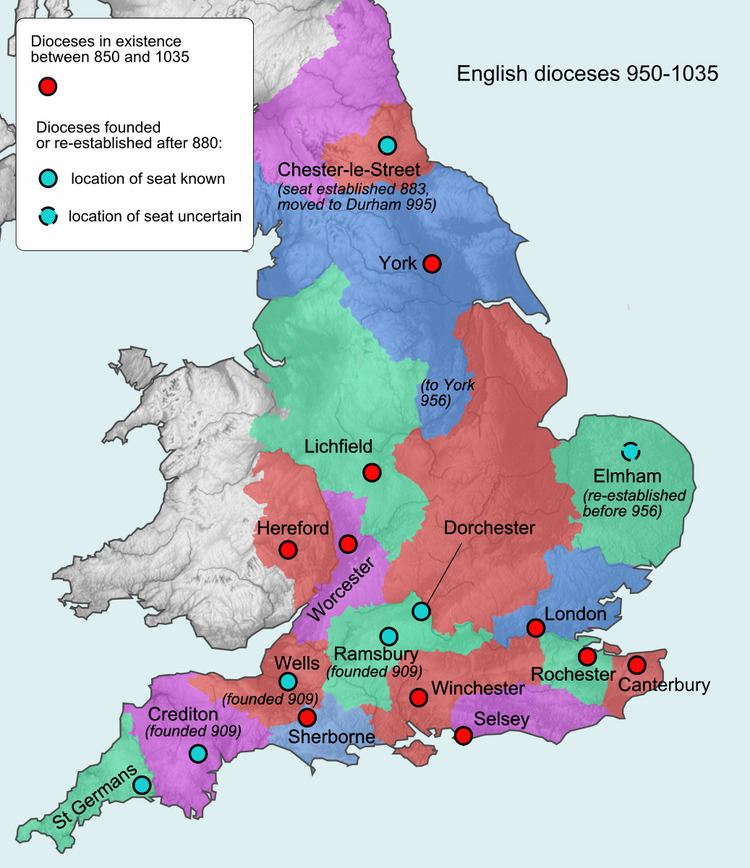 | ||
First incumbent AldhelmHerman (first bishop at Sarum) Formation 7091075 (translated to Salisbury) | ||
The Bishop of Salisbury is the ordinary of the Church of England's Diocese of Salisbury in the Province of Canterbury. The diocese covers much of the counties of Wiltshire and Dorset. The see is in the City of Salisbury where the bishop's seat is located at the Cathedral Church of the Blessed Virgin Mary. The current bishop is Nick Holtam, the 78th Bishop of Salisbury, who was consecrated at St Paul's Cathedral on 22 July 2011 and enthroned in Salisbury Cathedral on 15 October 2011.
History
The Diocese of Sherborne (founded c. AD 705) was the origin of the present diocese; St Aldhelm was its first bishop. Ramsbury's diocese was created from the northwestern territory of the bishop of Winchester in 909.
The Anglo-Saxon Diocese of Sherborne was established by Saint Aldhelm in about 705 and comprised the counties of Devon, Somerset, Dorset, and Cornwall. The diocese lost territory on the creation of the bishopric of Cornwall in the early 9th century, and lost further territory on the creation of the bishoprics of Wells and Crediton by Plegmund, Archbishop of Canterbury in 909.
In 1058, the Sherborne chapter elected Herman of Ramsbury as their own bishop. He had previously complained of the poverty of his diocese to the extent that, when his plan to become abbot of Malmesbury was blocked by Earl Godwin in 1055, he had abandoned his duties and left to become a monk at St Bertin in France. Following the Norman conquest, the 1075 Council of London united his two sees as a single diocese and translated them to the then-larger settlement around the royal castle at Salisbury (Old Sarum). With papal approval, this was later removed to New Sarum (modern Salisbury) in the 1220s.
Herman of Wilton, bishop of both Ramsbury and then Sherborne, obtained approval from Edward the Confessor to transfer his seat to Malmesbury, but this plan was blocked by local monks and Earl Godwin. Instead, following the Norman conquest, the 1075 Council of London named him bishop of Sarisberie (Latin: Seriberiensis episcopus), which had been made a royal stronghold by William I. This was at Old Sarum. Disputes between Bishops Herbert and Richard Poore and the sheriffs of Wiltshire led to the removal of the see in the 1220s to a new site in the plain. This was chartered as the city of New Sarum by King Henry III in 1227, but it wasn't until the 14th century that the office was described (by Bishop Wyvil) as the bishop of Sarum (episcopus Sarum). The diocese, like the city it administers, is now known as Salisbury. The archdeaconry around Salisbury, however, retains the name of Sarum.
Reforms within the Church of England led to the annexation of Dorset from the abolished diocese of Bristol in 1836; Berkshire, however, was removed the same year and given to Oxford. In 1925 and 1974, new suffragan bishops were appointed to assist the Bishop of Salisbury; the new offices were titled the bishops of Sherborne and Ramsbury, respectively. Until 2009 the bishops operated under an episcopal area scheme established in 1981, with each suffragan bishop having a formal geographical area of responsibility, and being known as "area bishops". The Bishop of Ramsbury had oversight of the diocese's parishes in Wiltshire, while the Bishop of Sherborne had oversight of the diocese's parishes in Dorset. This scheme was replaced to reflect the increased working across the whole diocese by all three bishops. The two suffragans may now legally function anywhere in the diocese, and the Bishop of Salisbury may delegate any of his functions to them.
